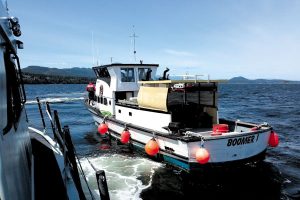CF crew race to save sinking vessel
By Lookout on Jul 14, 2014 with Comments 0

The 16-metre Boomer 1 departs the patrol craft Egret as it makes its way under escort into harbour after nearly sinking. Photo by MS Richard Loy, CFMETR
A lightning fast departure by a Canadian Forces patrol craft from alongside was likely the key to keeping a sinking civilian vessel afloat after it began taking on water near Nanoose Bay June 6.
Egret, one of the craft responsible for patrolling the torpedo test range operated by the Canadian Forces Maritime Experimental and Test Ranges (CFMETR), was having its windows replaced when a Mayday call crackled over the radio. While vessel master PO2 Kevin Hall ran from his shore office, Bos’n MS Dan Connelly and Engineer MS Rich Loy hastily landed the contracted maintenance crew and fired up the vessel’s twin jet drives.
“We got off so quickly it wasn’t until the Mayday was secured that I looked around and realized we didn’t have any windows on the starboard side,” said Hall. “But thanks to the professionalism of the crew we were first on scene, getting there even before vessels that were already in the area.”
On reaching Boomer 1, a 21-metre power boat, Hall rapidly assessed the emergency.
“The vessel’s bilge pump could not keep up with the water flowing in,” recalled Hall. “In other words, she was sinking.”
While Connelly calculated time and distance to the nearest safe harbour, Hall directed engineer Loy onto the foundering vessel to attempt to slow the influx of seawater. Hall remained on the radio, coordinating with the Rescue Coordination Centre, the approaching Coast Guard vessel Cape Cockburn out of nearby French Creek, and with another CFMETR vessel, the Canadian Forces Auxiliary Vessel (CFAV) Stikine.
For 26-year veteran Loy, working in confined spaces was nothing new. He had once been trapped for 20 minutes in the bilge of HMCS Algonquin after getting his foot caught between two pipes. It took two beefy stokers to pull him free. But working on the ageing Boomer 1 was no picnic.
“To be honest I was a little claustrophobic,” he said. “It was dark, there were exposed nails just above my head and water was pouring in. But I was determined to find the leak.”
What Loy found was proof that Boomer 1 wasn’t fit for sea. After pulling apart a cupboard and wriggling his way closer to the leak, he discovered gaps in the material meant to seal the hull’s horizontal wooden slats. Every time the vessel rolled to port he could see sunlight through a section of the starboard hull.
Fortunately, a member of the Cape Cockburn arrived carrying a pump to augment Loy’s efforts staunching the leak. When that proved ineffective, Hall had Stikine draw up alongside and employ its portable air pump. Although a little unorthodox, the pump cleared enough water that Boomer 1 could safely make harbour under Coast Guard escort.
Remarkably, Hall and his crew had only recently received a Commander RCN commendation for a similar rescue in the summer of 2012. But for the elderly couple piloting Boomer 1, he guessed the rescue was anything but routine.
“When vessels from professional organizations arrive at the drop of a hat that’s got to put someone at ease,” he said. “They were very worried, but we gave them peace of mind and the assurance they were going to be safe.”
Capt Jeff Manney, CFMETR
Filed Under: Top Stories
About the Author:





